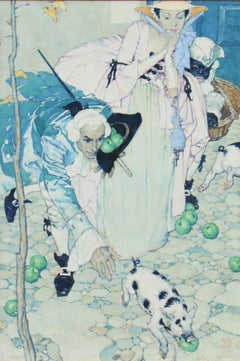Swords At Weehawken
1930s Figurative Paintings
Oil, Board, Laid Paper
People Also Browsed
Antique 19th Century Italian Romantic Settees
Silver Leaf
1950s Abstract Expressionist Abstract Paintings
Masonite, Acrylic
1980s Pop Art Figurative Prints
Board, Screen
19th Century Still-life Paintings
Oil
Antique Early 1900s British Edwardian Sports Equipment and Memorabilia
Oak
Vintage 1940s Tanzanian Tribal Chairs
Wood
21st Century and Contemporary American Sofas
Upholstery, Fiberglass
Antique 15th Century and Earlier Italian Classical Roman Figurative Scul...
Terracotta
Vintage 1930s French Art Deco Western European Rugs
Wool
20th Century American Mid-Century Modern Sofas
Chrome
19th Century Old Masters Figurative Paintings
Oil
Mid-20th Century Post-War Abstract Paintings
Ink, Gouache
Antique 15th Century and Earlier Mexican Natural Specimens
Other
Antique 19th Century French Napoleon III Panelling
Wood, Oak
20th Century Figurative Paintings
Canvas, Oil
Mid-20th Century Post-War Abstract Paintings
Ink, Gouache
Norman Rockwell for sale on 1stDibs
Norman Rockwell is among the most revered painters of the 20th century. His figurative and portrait paintings reflect an innocent and idyllic America described by the artist as "life as I would like it to be." For nearly 50 years, he illustrated the covers of The Saturday Evening Post in a rich and emotive style that gave distinctive personalities to his imagined characters. In total, Norman Rockwell created more than 4,000 works of art over the course of his life.
Rockwell was born in 1894 in New York City. His artistic aspirations took shape early on, and when he was 14 years old, he took classes at the New York School of the Art, which is now the Parsons School of Design. Later, he attended the Art Students League of New York, where he studied under influential painters Thomas Fogarty and George Bridgman. While still a teen, Rockwell became art director of the Boy Scouts of America publication Boys' Life.
At 21, Rockwell moved to New Rochelle, New York, and opened a studio with fellow illustrator Victor Clyde Forsythe. He created illustrations for magazines like Literary Digest and Life before his first cover for The Saturday Evening Post was published when he was 22. In 1939, after moving to Arlington, Vermont, Rockwell pivoted to making the nostalgic paintings of small-town and iconic America for which he is best known — scenes of Christmas dinner, children playing in the street and national treasures like Ruby Bridges and Rosie the Riveter.
In 1943, a speech previously given by President Franklin Roosevelt inspired Rockwell to create his most famous series, “The Four Freedoms,” which was exhibited all over the United States. The series included four pieces entitled Freedom of Speech, Freedom to Worship, Freedom from Want and Freedom from Fear.
Rockwell moved with his family to Stockbridge, Massachusetts, in 1953, where he spent the rest of his life. My Adventures as an Illustrator — the autobiography Rockwell wrote with the help of his son, Thomas — was published in 1960. In 1963, Rockwell ceased working with The Saturday Evening Post and started drawing illustrations for Look magazine.
The world’s largest collection of original Rockwell art can be found at the Norman Rockwell Museum in Stockbridge. The artist was awarded the Presidential Medal of Freedom in 1977, and he passed away peacefully in his home the following year.
On 1stDibs, find a collection of original Norman Rockwell paintings, prints, drawings and other works.
Finding the Right Figurative-paintings for You
Figurative art, as opposed to abstract art, retains features from the observable world in its representational depictions of subject matter. Most commonly, figurative paintings reference and explore the human body, but they can also include landscapes, architecture, plants and animals — all portrayed with realism.
While the oldest figurative art dates back tens of thousands of years to cave wall paintings, figurative works made from observation became especially prominent in the early Renaissance. Artists like Michelangelo, Leonardo da Vinci and other Renaissance masters created naturalistic representations of their subjects.
Pablo Picasso is lauded for laying the foundation for modern figurative art in the 1920s. Although abstracted, this work held a strong connection to representing people and other subjects. Other famous figurative artists include Francis Bacon and Lucian Freud. Figurative art in the 20th century would span such diverse genres as Expressionism, Pop art and Surrealism.
Today, a number of figural artists — such as Sedrick Huckaby, Daisy Patton and Eileen Cooper — are making art that uses the human body as its subject.
Because figurative art represents subjects from the real world, natural colors are common in these paintings. A piece of figurative art can be an exciting starting point for setting a tone and creating a color palette in a room.
Browse an extensive collection of figurative paintings on 1stDibs.
